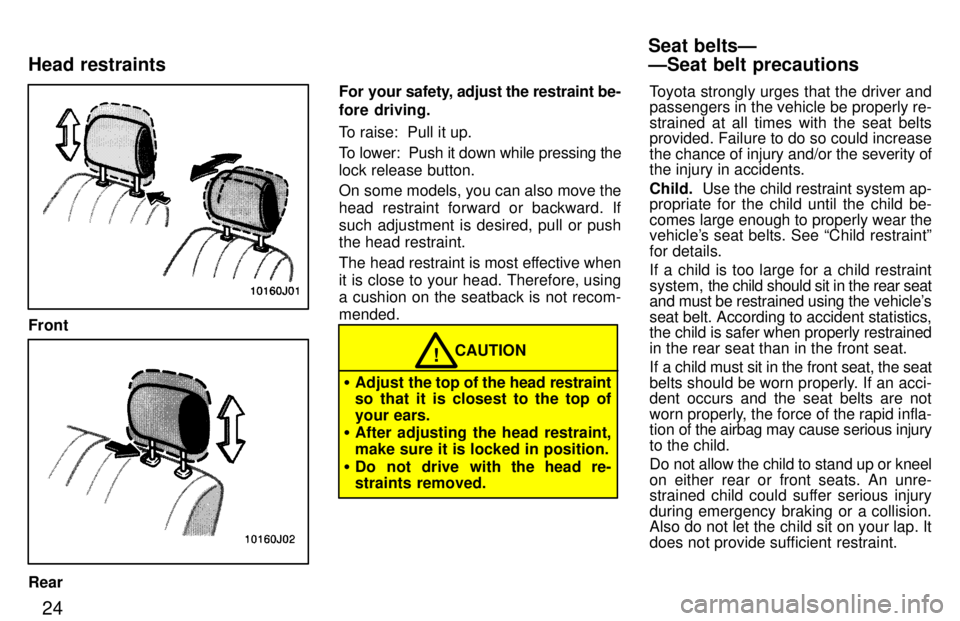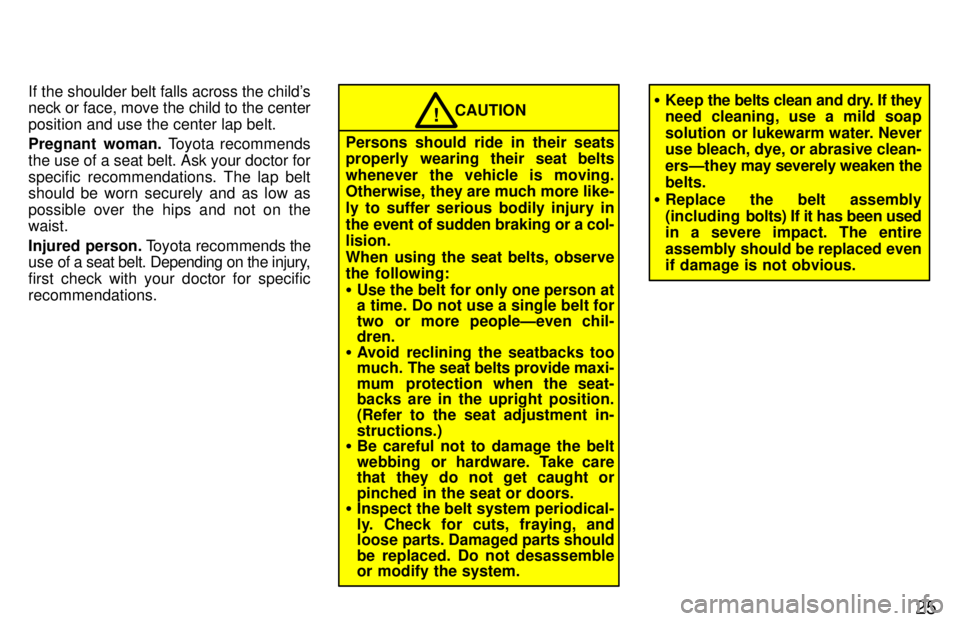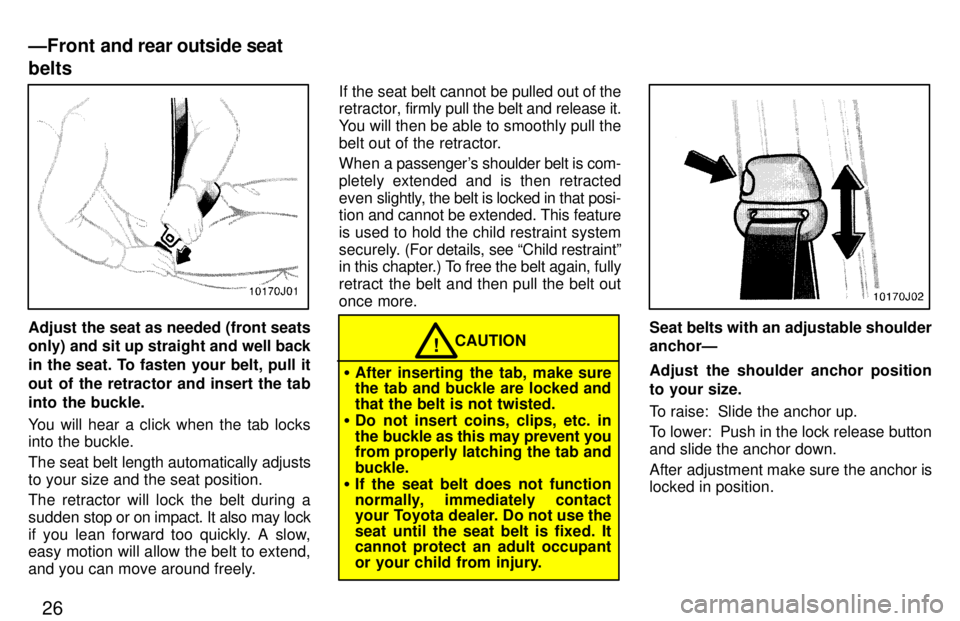Page 20 of 223

24
Front
RearFor your s
afety, adjust the restraint be-
fore driving.
To raise: Pull it up.
To lower: Push it down while pressing the lock release button.
On some models, you can also move the
head restraint forward or backward. If
such adjustment is desired, pull or push the head restraint.
The head restraint is most effective when
it is close to your head. Therefore, using a cushion on the seatback is not recom- mended.
CAUTION!
� Adjust the top of the head restraint
so that it is closest to the top of
your ears.
� After adjusting the head restraint,
make sure it is locked in position.
� Do not drive with the head re-
straints removed. Toyota strongly urges that the driver and passengers in the vehicle be properly re- strained at all times with the seat belts
provided. Failure to do so could increase
the chance of injury and/or the severity of the injury in accidents. Child.
Use the child restraint system ap-
propriate for the child until the child be-
comes large enough to properly wear the
vehicle's seat belts. See Child restraintº
for details.
If a child is too large for a child restraint
system, the child should sit in the rear seat
and must be restrained using the vehicle's
seat belt. According to accident statistics, the child is safer when properly restrained
in the rear seat than in the front seat.
If a child must sit in the front seat, the seat
belts should be worn properly. If an acci- dent occurs and the seat belts are not
worn properly, the force of the rapid infla-
tion of the airbag may cause serious injury
to the child.
Do not allow the child to stand up or kneel
on either rear or front seats. An unre-
strained child could suffer serious injury
during emergency braking or a collision.
Also do not let the child sit on your lap. It
does not provide sufficient restraint.
Seat beltsÐ ÐSeat belt precautions
Head restraints
Page 21 of 223

25
If the shoulder belt falls across the child's neck or face, move the child to the center
position and use the center lap belt.
Pregnant woman.
Toyota recommends
the use of a seat belt. Ask your doctor for
specific recommendations. The lap belt
should be worn securely and as low as
possible over the hips and not on the waist.
Injured person. Toyota recommends the
use of a seat belt. Depending on the injury,
first check with your doctor for specificrecommendations.
CAUTION!
Persons should ride in their seats
properly wearing their seat belts
whenever the vehicle is moving.
Otherwise, they are much more like-
ly to suffer serious bodily injury in
the event of sudden braking or a col- lision.
When using the seat belts, observe
the following: � Use the belt for only one person at
a time. Do not use a single belt for
two or more peopleÐeven chil- dren.
� Avoid reclining the seatbacks too
much. The seat belts provide maxi-
mum protection when the seat-backs are in the upright position.
(Refer to the seat adjustment in-structions.)
� Be careful not to damage the belt
webbing or hardware. Take care
that they do not get caught or
pinched in the seat or doors.
� Inspect the belt system periodical-
ly. Check for cuts, fraying, and
loose parts. Damaged parts should
be replaced. Do not desassemble
or modify the system.
� Keep the belts clean and dry. If they
need cleaning, use a mild soap
solution or lukewarm water. Never
use bleach, dye, or abrasive clean-
ersÐthey may severely weaken the
belts.
� Replace the belt assembly
(including bolts) If it has been used
in a severe impact. The entire
assembly should be replaced even
if damage is not obvious.
Page 22 of 223

26
Adjust the seat as needed (front seats only) and sit up straight and well back
in the seat. To fasten your belt, pull it
out of the retractor and insert the tab
into the buckle.
You will hear a click when the tab locks into the buckle.
The seat belt length automatically adjusts
to your size and the seat position.
The retractor will lock the belt during a
sudden stop or on impact. It also may lock
if you lean forward too quickly. A slow, easy motion will allow the belt to extend,
and you can move around freely. If the seat belt cannot be pulled out of the
retractor,
firmly pull the belt and release it.
You will then be able to smoothly pull the
belt out of the retractor.
When a passenger's shoulder belt is com-
pletely extended and is then retracted
even slightly, the belt is locked in that posi-
tion and cannot be extended. This feature
is used to hold the child restraint system
securely. (For details, see Child restraintº
in this chapter.) To free the belt again, fully
retract the belt and then pull the belt out
once more.CAUTION!
� After inserting the tab, make sure
the tab and buckle are locked and that the belt is not twisted.
� Do not insert coins, clips, etc. in
the buckle as this may prevent you
from properly latching the tab and buckle.
� If the seat belt does not function
normally, immediately contact
your Toyota dealer. Do not use the
seat until the seat belt is fixed. It cannot protect an adult occupant
or your child from injury.
Seat belts with an adjustable shoulder anchorÐ
Adjust the shoulder anchor position
to your size.
To raise: Slide the anchor up.
To lower: Push in the lock release button
and slide the anchor down.
After adjustment make sure the anchor is
locked in position.
ÐFront
and rear outside seat
belts
Page 25 of 223
29
Remove excess length of the belt and adjust the belt position.
To shorten the belt, pull the free end of the belt. Position the lap belt as low as possible on your hipsÐnot on your waist, thn adjust it
to a snug fit.
CAUTION!
High-positioned and loose-fitting
lap belts could cause severe injuries
due to sliding under the lap belt
during a collision. Keep the lap belt
positioned as low on hips as possible.
To release the belt, press the buckle-
release button.The rear seat belts can be stowed
when not in use.
Seat belts must be stowed before you fold
the seat back. (See Rear seatsÐFold
down rear seatº in this chapter.)
ÐStowing rear seat belts
Page 36 of 223
39
(A) INFANT SEAT INSTALLATION
An Infant seat is used in rear-facing onlyCAUTION!
Do not use a rear-facing child rees- traint system in the rear seat if it in- terferes with the lock mechanism of
the front seats. This can cause se-
vere injury to the child and front pas-
senger in case of sudden braking ora collision.
1. Run the center lap and shoulder belt through or around the infant seat fol-
lowing the instructions provided by its
manufacturer and insert the tab into the buckle taking care not to twist the lap belt.
ÐInstallation with 2-point type seat belt
Page 38 of 223
41
3. To remove the infant seat, press thebuckle-release button.(B) CONVERTIBLE SEAT INSTALLA-
TION
A convertible seats is used in forward-
facing and rear-facing depending on
the child's age and size. When instal-
ling, follow the manufacturer's in-
struction about the applicable child's
age and size as well as direction for
installing of a child restraint system.CAUTION!
Do not use a rear-facing child re-
straint system in the rear seat if it in-
terferes with the lock mechanism of
the front seats. This can cause se-
vere injury to the child and front pas-
senger in case of sudden braking ora collision.
Page 44 of 223
47
CAUTION!
� Never use a rear-facing child re-
straint system in the front seat be- cause the force of the rapid infla-
tion of the passenger airbag can cause severe injury to the child.
�Only when it is unavoidable
should a forward-facing child re-
straint system be used on the front
seat. Always move the seat as farback as possible because theforce of deploying airbag would cause serious injury to the child.� Do not use a rear-facing child re-
straint system in the rear seat if it
interferes with the lock mecha-
nism of the front seats. This can
cause severe injury to the child
and front passenger in case of
sudden braking or a collision.
Page 122 of 223
125
�
To cool off your Toyota after it has been
parked in the hot sun, drive with the
windows open for a few minutes. This
vents the hot air, allowing the air condi-
tioning to cool the interior more quickly.
� Make sure the air intake g rilles in front
of the windshield are not blocked (by
leaves or snow, for example).
� On humid days, do not blow cold air on
the windshield. The windshield could
fog up because of the difference in airtemperature on the inside and outside
of the windshield.
� Keep the area under the front seats
clear to allow air to circulate through-out the vehicle.
� On cold days, move the fan speed to
HIº for a minute to help clear the in-
take ducts of snow or moisture. This
can reduce the amount of fogging onthe windows.
ÐAir flow selector settings
ÐOpening tips